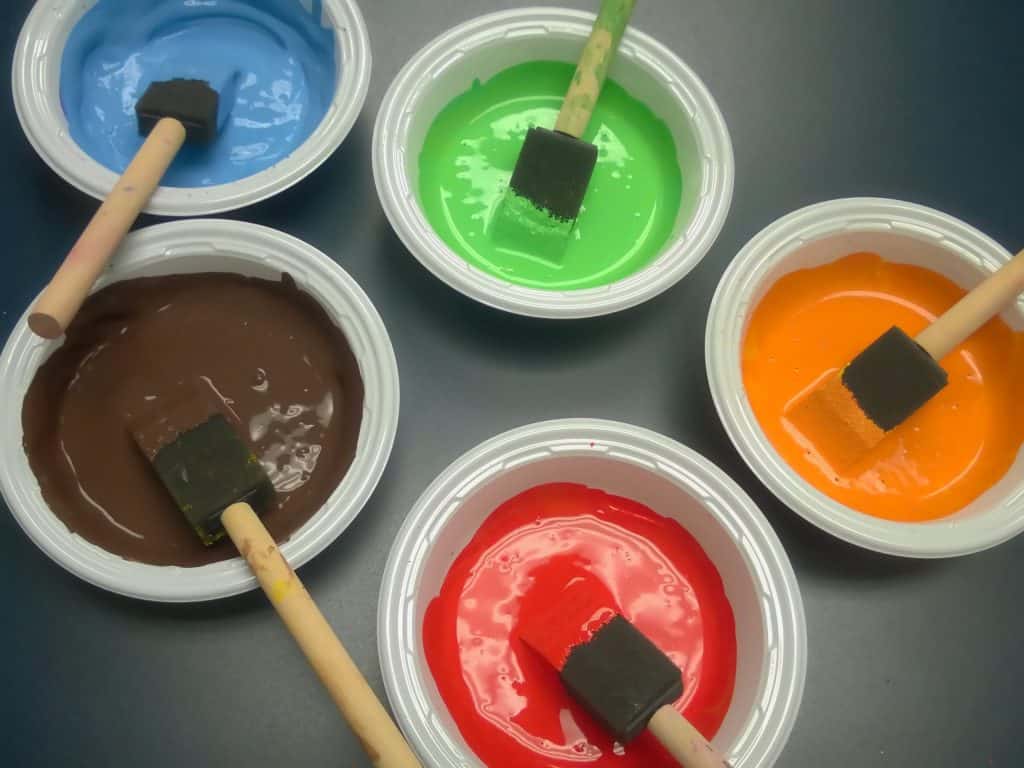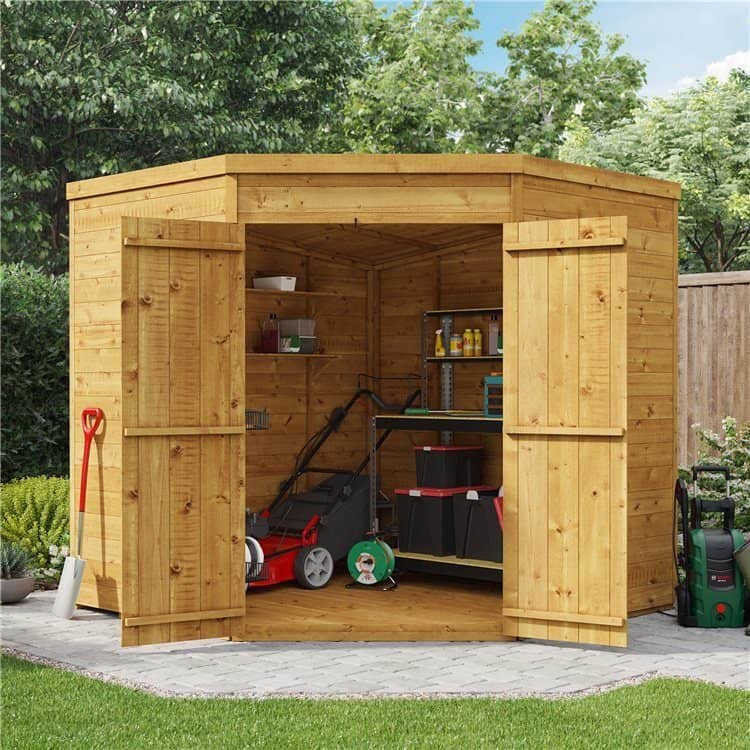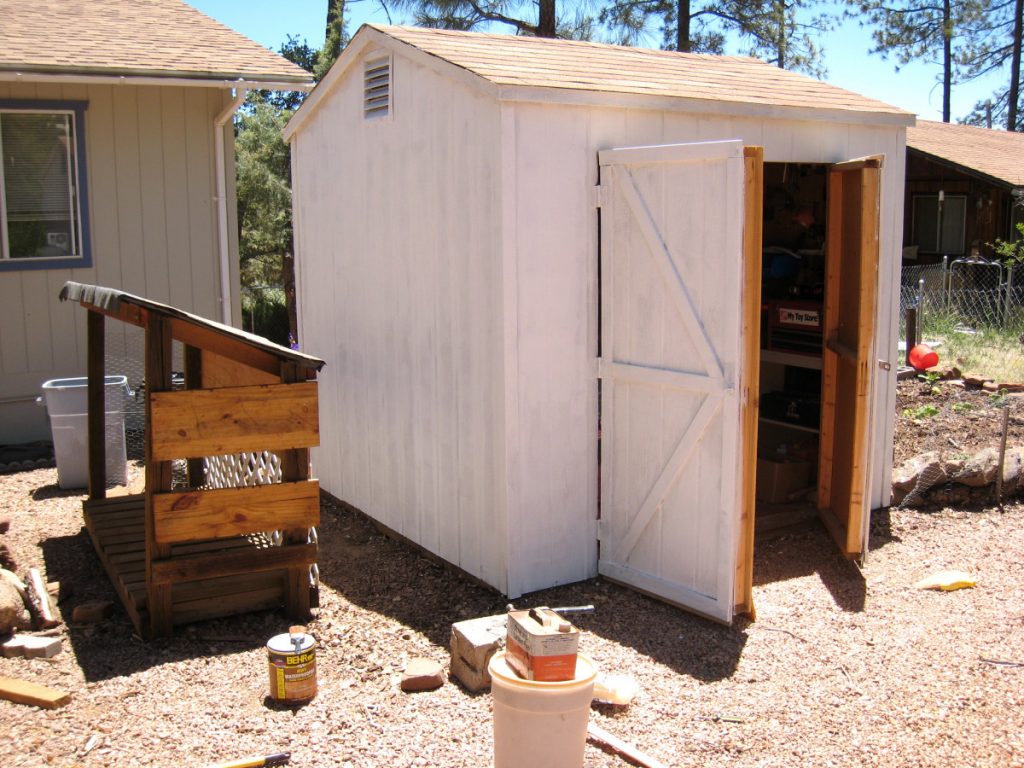Jump to:
Scorching heat, heavy rainfall, strong winds, and snowfall. Garden sheds bravely endure this ever-changing British weather year after year. Constant exposure can lead to wear and tear, leaving your structure looking dull. Luckily, there’s a simple yet powerful solution that awaits: a fresh coat of paint.
Giving your outdoor building a facelift with a coat of paint can bring it back to life. At the same time, it adds an extra layer of protection from the elements. The best part? It’s a straightforward process that anyone can tackle with ease.
Ready to give your shed the makeover it deserves? Follow these practical tips, and in no time, it will stand strong for the seasons to come!

Why Should You Paint Your Shed?
Imagine the relentless UV rays assaulting the wood, causing it to lose its lustre over time. Or the unyielding rainwater inducing unsightly splits and cracks. Well, your shed deserves better than that!
If your wooden shed is not pressure-treated, regular maintenance becomes essential. But why settle for that when you can choose a ready-made pressure treated shed? The choice is evident – timber that has undergone a special process wins every time.
But even if your shed lacks this treatment, there’s a solution to prolong its lifespan. And this age-old question persists: should you paint your shed? The answer is crystal clear. Doing so serves not just one but two invaluable purposes that you can’t afford to overlook.
First, the aesthetics. A fresh coat of paint breathes new life into the exterior. It transforms the structure into a picturesque focal point. But that’s not all! The true power of paint lies in its ability to shield your shed from the harshest weather conditions.

Paint vs Wood Stain
Now, you might be pondering the difference between paint and a shed treatment like a stain. Both materials seal and protect the natural grain, preventing damage and fading. You can even apply stain over painted wood, so the possibilities are endless.
Paints boast a bold and dramatic flair. Meanwhile, stains embrace a warm, rustic, and natural finish. Each creates a unique ambience that complements your outdoor space. Understanding the key difference between the two helps.
Paint forms a protective layer atop the surface. Though it demands a bit more attention and patience. Usually, requiring multiple coats to achieve perfection. However, its superior coverage makes it ideal for concealing flaws and imperfections.
Stain, in contrast, gracefully seeps into the wood, enhancing its natural beauty. Another advantage is its hassle-free application – no primer required. Often, just one coat does the trick, saving you precious time.
Top tip: Opt for high-quality paints and stains. Look for products designed to brighten up and protect garden buildings. For stain, consider the Protek Wood Stain and Protector 5ltr. It offers longevity that can span up to five years or more – a testament to its reliability.
Things to Consider Before Painting Your Shed
Before you spruce up your shed with a lick of paint, there are a few things you need to consider. We’ve curated some advice from the experts below, so make sure to bear it in mind.

1. Prepare the shed
If you’re painting an old building, cleaning it is a must – both interior and exterior. Wipe off any debris, spider webs, mould, and other grime from floor to ceiling.
You can use a mixture of dish soap and water to scrub off dirt and grime. Or you can use a power washer, if you have one, to speed up the cleaning process. To add finesse to your cleaning routine, explore other liquid cleaning solutions:
- White vinegar: Create a mixture of 30% white vinegar and 70% water. And voila! You have an eco-friendly yet potent cleaning solution.
- Laundry detergent: Mix ⅓ cup of laundry detergent with 6 gallons of water in a large bucket. This should be enough to tackle stubborn dirt with ease.
- Bicarbonate of soda: Blend 1 ½ cups of bicarbonate of soda with ½ cup of soap. Consider adding a splash of essential oil for a refreshing fragrance.
You’ll also want to make sure that the surface has been smoothed down. Check for any loose or rusted nails. Seal or change them immediately.
If there are any holes or cracks, fill them up. You can use a silicone caulk for a long-lasting option. Lastly, allow the surface to set over for more than a day before painting.

2. Check the weather
Let’s say your shed is all dry and clean and ready for painting. But it starts to rain out of nowhere! You weren’t expecting it, or maybe you didn’t double-check the weather forecast. Well, now you’ve got an unpainted, wet shed.
Since the process sort of has to be done outdoors, it’s important to consider the weather. Otherwise, your hard work will all be for nothing.
Try to plan for the best day for painting. Temperatures below 10°C can impact the paint performance and the drying process. Likewise, if the weather is too hot, paint might flake. Additionally, choose a day that isn’t too windy to allow your newly painted shed to dry.
Top tip: Be sure the walls are completely dry after painting. Water droplets, high humidity, and leaks can cause water-filled bubbles on it.
3. Protect the garden
You don’t want your vegetation or ornamental plants to be covered in bright paint, do you? Your neighbours won’t be pleased to paint theirs either!
To protect the surroundings, including the fences, walls, and ground, use dust sheets in case of any drips. This is especially important if you plan on using a paint sprayer or an air compressor.
It would also be great if you could cover the shed’s door handles, locks, and windows. You can use a newspaper and masking tape. With this done, you’ll only paint the building in the desired areas.
Consider unscrewing any handles or fittings so you can paint underneath and achieve a neat finish.
If you’re using paintbrushes, make sure to equip yourself with smaller ones to cover these details. Keeping a supply of rags or towels on hand is also a good idea. When there’s a spill, you can clean it right away.

Painting Your Shed
Step 1: Prepare the surface
Clean the shed, inside and out thoroughly, removing debris, spider webs, and grime. Repair any holes, cracks, or loose nails and allow the surface to dry completely.
Step 2: Choose the right paint
Select a high-quality exterior paint suitable for wooden surfaces. Consider weather-resistant and UV-protective paints for enhanced durability.
Step 3: Prime (if needed)
Apply your paint evenly to the shed’s surface if it requires a primer. Ensure a better adhesion and smoother finish.
Step 4: Start painting
Begin painting from the top of the shed, working your way down. Use a paintbrush for edges and corners and a roller for larger areas. Apply thin, even coats, allowing enough drying time between each layer.
Top tip: If you want to use multiple colours on the exterior, apply wood treatment and primer. Wait for them to dry, then paint the colour you want. Wait for it to dry, then paint the other colours!
Step 5: Consider a second coat
Apply a second coat of paint after the first one dries completely. Doing so will help you achieve optimal coverage and longevity.
Step 6: Clean up
Clean your paintbrushes and rollers with water. Or you may use the recommended solvent for the paint used.
Step 7: Admire your work
Once the final coat dries, step back and admire your freshly painted shed. It’s now ready to withstand the elements and add charm to your outdoor space for years to come!
That’s a Wrap!
In a day, you’ve managed to give your shed a makeover. Pat yourself on the back for your hard labour. And more importantly, take a look at the outcome. Sit back and enjoy the view.
Hiring a professional can be your other option if you think you can’t do it yourself. Either way, we hope this guide will help you give your garden a facelift and breathe life into your old wooden shed.
Who knows? Your neighbours might ask for your help to paint their garden shed someday. But before you do, make sure you know what their shed type is. Obviously, metal structures and plastic units have different painting requirements.
Shop Garden Sheds









